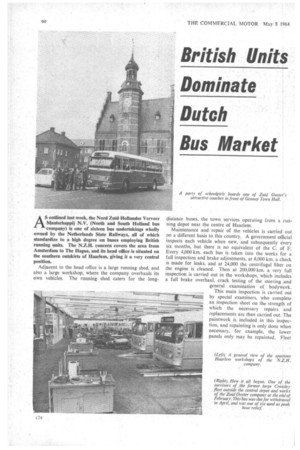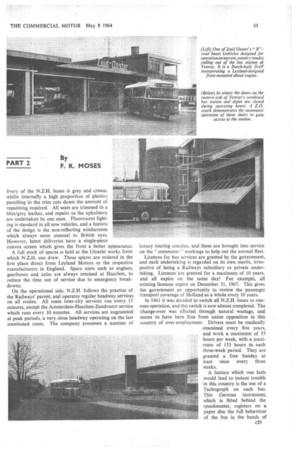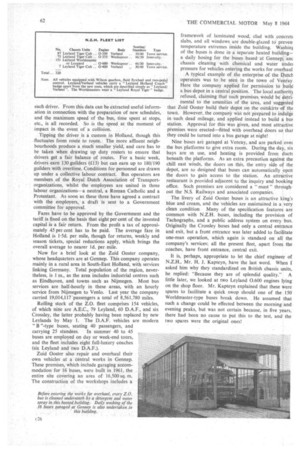British Units Dominate Dutch Bus Market
Page 62

Page 63

Page 64

If you've noticed an error in this article please click here to report it so we can fix it.
By F. K. MOSES
distance buses, the town services operating from a running depot near the centre of Haarlem.
Maintenance and repair of the vehicles is carried out on a different basis to this country: A government official inspects each vehicle when new, and subsequently every six months, but there is no equivalent of the C. of F. Every 4,000 km. each bus is taken into the works for a full inspection and brake adjustments, at 8,000 km. a check is made for leaks, and at 24,000 the centrifugal filter on the engine is cleaned. Then at 200,000 km. a very full inspection is carried out in the workshops, which includes a full brake overhaul. crack testing of the steering and general examination of bodywork.
This main inspection is carried out by special examiners, who complete an inspection sheet on the strength of which the necessary repairs and replacements are then carried out. The paintwork is included in this inspection, and repainting is only done when necessary, for example, the lower panels only may be repainted. Fleet livery of the N.Z.H. buses is grey and cream. whilst internally a high proportion of plastics panelling in the trim cats down the amount of repainting required. All seats are trimmed in a blue/grey leather, and repairs to the upholstery are undertaken by one man. Fluorescent lighting is standard in all new vehicles, and a feature of the design is the non-reflecting windscreens which always seem unusual to British eyes. However, latest deliveries have a single-piece convex screen which gives the front a better appearance.
A full stock of spares is held at the Utrecht works from which N.Z.H. can draw. These spares are ordered in the first place direct from Leyland Motors or the respective manufacturers in England. Spare units such as engines, gearboxes and axles are always retained at Haarlem, to reduce the time out of service due to emergency breakdowns.
On the operational side, N.Z.H. follows the practice of the Railways' parent, and operates regular headway services on all routes. All main inter-city services run every 15 minutes, except the Amsterdam-Haarlem-Zandvoort service which runs every 10 minutes. All services are augmented at peak periods, a very close headway operating on the last mentioned route. The company possesses a number of luxury touring coaches, and these are brought into service on the " commuter " workings to help out the normal fleet.
Licences for bus services are granted by the government, and each undertaking is regarded on its own merits, irrespective of being a Railways subsidiary or private undertaking. Licences are granted for a maximum of 10 years, and all expire on the same day! For example, all existing licences expire on December 31, 1967. This gives the government an opportunity to review the passenger transport coverage of Holland as a whole every 10 years.
In 1961 it was decided to switch all N.Z.H. buses to oneman operation, and this switch is now almost completed. The change-over was effected through natural wastage, and seems to have been free from union ooposition in this country of over-employment. Drivers must be medically examined every five years, and work a maximum of 55 hours per week, with a maximum of 153 hours in each three-week period. They are granted a free Sunday at least once every three weeks. • A feature which one feels would lead to instant trouble in this country is the use of a Tachograph on each bus. This German instrument, which is fitted behind the speedometer, registers on a paper disc the full behaviour of the bus in the hands of
each driver. From this data can be extracted useful information in connection with the preparation of new schedules, and the maximum speed of the bus, time spent at stops, etc., is all recorded. So is the speed at the moment of impact in the event of a collision.
Tipping the driver is a custom in Holland, though this fluctuates from route to route. The more affluent neighbourhoods produce a much smaller yield, and care has to be taken when drawing up duty rosters to ensure that drivers get a fair balance of routes. For a basic week, drivers earn 130 guilders (£13) but can earn up to 180/190 guilders with overtime. Conditions for personnel are drawn up under a collective labour contract. Bus operators are members of the Royal Dutch Association of Transportorganizations, whilst the employees are united in three labour organizations—a neutral, a Roman Catholic and a Protestant. As soon as these three have agreed a contract with the employers, a draft is sent to a Government committee for approval.
Fares have to be approved by the Government and the tariff is fixed on the basis that eight per cent of the invested capital is a fair return. From the profit a tax of approximately 45 per cent has to be paid. The average fare in Holland is 1.5d. per mile, though for returns, weekly and season tickets, special reductions apply, which brings the overall average to nearer 1 d. per mile.
Now for a brief look at the Zuid Ooster company, whose headquarters are at Gennep. This company operates mainly in a rural area in South-East Holland, with services linking Germany. Total population of the region, nevertheless, is 1 m., as the area includes industrial centres such as Eindhoven, and towns such as Nijmegen. Most bus services are half-hourly in these areas, with an hourly service from Nijmegen to Venlo. Last year the company carried 19,014,117 passengers a total of 8,561,780 miles.
Rolling stock of the Z.O. fleet comprises 154 vehicles, of which nine are A.E.C., 79 Leyland, 60 D.A.F., and six Crossley, the latter probably having been replaced by new Levlands by May 1. The D.A.F. vehicles are modern "B "-type buses, seating 40 passengers, and carrying 25 standees. In summer 40 to 45 buses are employed on day or week-end tours, and the fleet includes eight full-luxury coaches (six Leyland and two D.A.F.).
Zuid Ooster also repair and overhaul their own vehicles at a central works in Gennep. These premises, which include garaging accommodation for 16 buses, were built in 1961, the entire site covering an area of 16,500 sq. m. The construction of the workshops includes a framework of laminated wood, clad with concrett slabs, and all windows are double-glazed to preven temperature extremes inside the building. Washini of the buses is done in a separate heated building— a daily hosing for the buses based at Gennep, an chassis cleaning with chemical and water uncle] pressure for vehicles entering the works for overhaul
A typical example of the enterprise of the Putc11 operators was to be seen in the town of Venray Here the company applied for permission to build a bus depot in a central position. The local authority refused, claiming that such premises would be detrimental to the amenities of the area, and suggested that Zuid Ooster build their depot on the outskirts of the town. However, the company vvaS mit prepared to indulge in such dead mileage, and applied instead to build a bus station. Approval for this was given, and most attractive premises were erected—fitted with overhead doors so that they could be turned into a bus garage at night!
Nine buses are garaged at Venray, and are parked °vet the bus platforms to give extra room. During the day, six bays are in use, and heating is provided from ducts beneath the platforms. As an extra precaution against the chill east winds, the doors on .this, the entry side of the depot, are so designed that buses can automatically open the doors to gain access to the station. An attractive restaurant is provided adjacent to the inquiry and booking office. Such premises are considered a " must " throughout the N.S. Railways and associated companies.
The livery of Zuid Ooster buses is an attractive king's blue and cream, and the vehicles are maintained in a very clean condition Many of the specification features are common with N.Z.H. buses, including the provision of Tachographs, and a public address system on every bus. Originally the Crossley buses had only a central entrance and exit, but a front entrance was later added to facilitate one-man operation, which again is standard on all the company's services; all the present fleet, apart from the coaches, have front entrance, central exit.
It is, perhaps, appropriate to let the chief engineer of N.Z.H., Mr. H. J. Kapteyn, have the last word. When I asked him why they standardized on British chassis units, he replied: "Because they are of splendid quality." A little later, we looked at two Leyland 0.600 engines lying on the shop floor. Mr. Kapteyn explained that these were spares to facilitate a quick swop should one of the 150 Worldmaster-type buses break down. He assumed that such a change could be effected between the morning and evening peaks, but was not certain because, in five years, there had been no cause to put this to the test, and the two spares were the original ones!












































































































